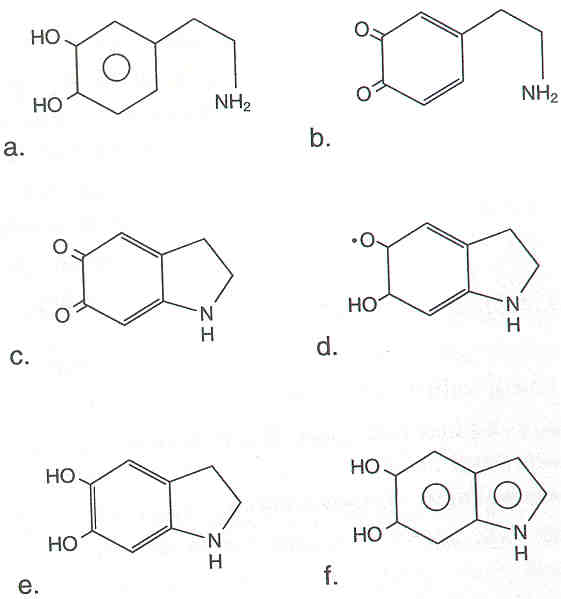
| MadSci Network: Neuroscience |
The answer to the question is: yes. Scientists gave this substance the name
neuromelanin to distinguish it from melanin in the skin.
Neuromelanin has been identified (in 1965) as a polymer made up of units of
5,6-dihydroxy indole (see figure), an oxidative product of dopamine
metabolism. The only feature actually making it different from skin melanin
is the metabolic pathway leading to its formation. This 'auto-oxidative
pathway' has only recently been elucidated (more detailed description
in ref. 1).

Neuromelanin's role is rather obscure (as of yet). It gives specific
populations of (dopaminergic) neurons in the substantia nigra ('black
substance'), an assembly of cells in the midbrain, their characteristic
color. Scientists assume a role for it in neurodegenerative diseases such
as Alzheimer's Disease and most notably Parkinson's Disease (which is
characterized by destruction of dopamine/neuromelanin containing cells).
Whether this is pure conincidence or whether neuromelanin actively
contributes to cell death is subject of intensive research. Neuromelanin
chelates metal ions such as aluminum and iron and binds some neurotoxic
substances (MPTP - note though that this is a substance used in
experimental research), all of them implicated in the etiology of
Parkinson's.
In addition, one of the intermediates in the pathway (adrenochrome) is
itself cytotoxic and polymorphonuclear leucocytes (immune cell which kills
bacteria) use it as a weapon in the body's defense against pathogens. Yet,
in other cells it should probably be sequestered or eliminated in other
ways (antioxidants, radical scavengers, cytochrome P450 system, etc., see
also p. 161 in ref. 1) for else it would harm these cells.
Smythies and Galzigna also hypothesize that some toxic intermediates in the
auto-oxidative pathway (dopamine quinones, highly reactive molecules) might
contribute to PD if not kept at bay by specific mechanisms.
That's the more interesting information I retrieved after browsing the
literature on the subject. Actually, I only read one article completely
(ref. 1), the abstracts of others for lack of availability of the journals
(refs. 2 - 6) and checked on some on-line references.
You see, there are still a lot of questions waiting to be answered.
I hope this helps a little bit. For further questions you are welcome to email me.
References:1-6: Medline search for 'neuromelanin AND review' (URL: http://www.ncbi.nlm.nih.gov/entrez/query.fcgi?db=PubMed&te rm=neurom elanin+AND+review)
7-8: Google Search for 'neuromelanin' (http://www.google.com/). You may check some of the other links if you want to.
Try the links in the MadSci Library for more information on Neuroscience.